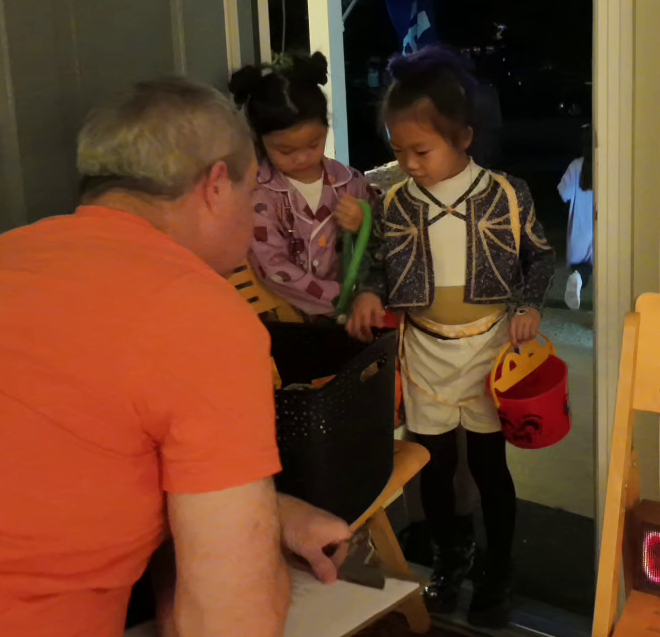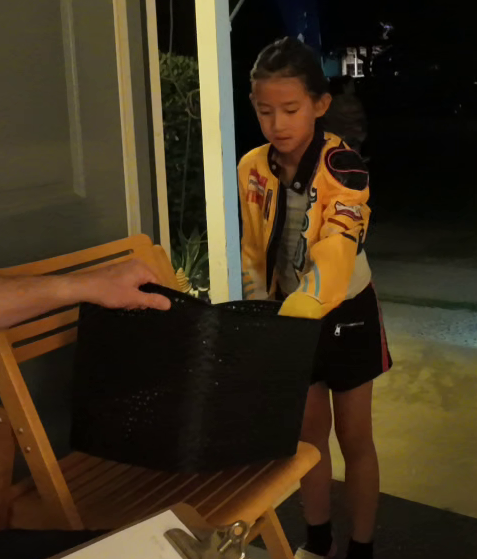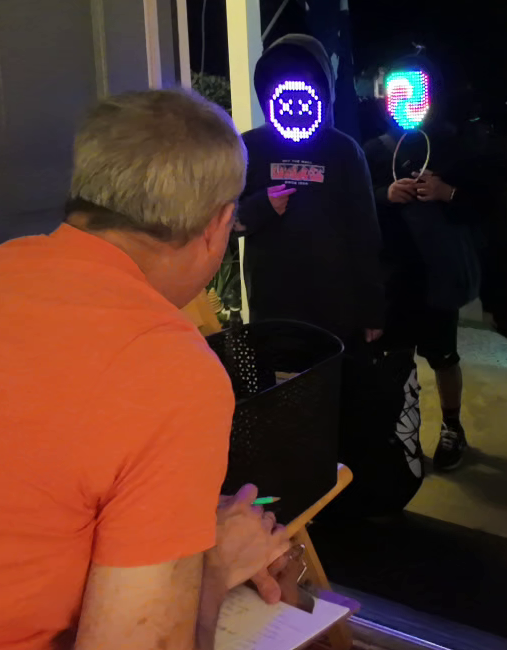I was asked to make a deflector to keep the air conditioner from blowing on Michele while she worked at the long arm quilter.
Bee Hive Inspection – November 7th, 2025
A brief hive inspection after not being able to for several months.
Water leak from the fridge
Halloween 2025
Cruft Manor has Halloween traditions every year:
1. We give out full size candies
2. Make a listing of all costumes
3. Make a timelapse movie
This year marks the 20th year of keeping stats on the children’s costumes.
Our life was quite different 20 years ago. Hard to believe so much time has past yet it feels like just yesterday our kids were children.
Back to the important stuff, handing out candy!
I let the kids choose their candy themselves. This can sometimes lead to a prolonged choosing process and debate. The moments of “OMG” and “wow” are wonderful as they realize the candies are full size.

The excitement upon seeing full size candies makes it all worth it.

When people come to the door, I ask every person what they were dressed as and wrote down their answers. I am careful to ask what they are, accepting their answers rather than interpreting what I see.
You can see the clipboard I use to write down what the kids tell me they are dressed as.
The time-lapse takes place over about four hours that is reduced to under two minutes for your viewing pleasure.
I just had back surgery, so we didn’t put up decorations and the setup was so I didn’t have to bend or lift much.
Here is the timelapse of Halloween this year.
A few of the costumes I liked this year.


KPop Demon Hunters was everywhere tonight. Here are a couple of Rumi.

Jinu from KPop Demon Hunters. The Honmoon was at risk.

Pumpkin from Dandy’s World Roblox (a video game)

I liked these LED masks. I need one.

Sid Wilson from Slipknot wins for originality.
There was a large group of boys all wearing M&Ms costumes. Someone must have gotten a deal on them. KPop Demon Hunters was clearly popping to the top of the list. The old standbys like witches, cats, Spiderman, and vampires all rise up the list as well.
This Halloween makes it 20 years of data to compare, though 2005, 2006, 2007, 2008, 2009, 2010, 2011, 2012, 2013, 2014, 2015, 2016, 2017, 2018, 2019, 2021, 2022, 2023, & 2024.
We did not give out candy in 2020 due to the pandemic.
Here are the top costumes over the last 20 years.

As AIs are in vogue in 2025, I asked six different LLMs to predict the visitor turnout based on trends, day of the week, and anything else. I gave them the stat comparisons for the last 19 years.
Halloween Candy predictions by AI:
Claude: My Prediction: 175-195 visitors
ChatGPT: Estimated visitors for 2025: 185–200 kids.
Gemini: 165 – 190 Visitors
Meta: Around 150-180 people might stop by the house.
Le Chat: You can reasonably expect 170–190 visitors
Deepseek: Maybe 120–125 range.
The number of people stopping by was 163, on the low end of most predictions.
This year’s complete costume list of 163 people:
Number Costume
8 M&Ms
6 Rumi – K Pop Demon Hunters
5 Zoey – K Pop Demon Hunters
4 Witch
3 Cat
3 Dinosaur
3 Ghost Face
3 Jinu – K Pop Demon Hunters
3 Spiderman
3 Vampire
3 Zombie
2 Alvin of the Chipmunks
2 Barbie from the Movie
2 Carebear
2 Chickalla
2 Chuckie
2 Grim Reaper
2 LED Mask
2 Mira – K Pop Demon Hunters
2 No Face
2 Saja Boy – K Pop Demon Hunters
2 Scream
2 Snow White
2 Superman
2 The Birds
1 “I don’t know”
1 “My own character”
1 “My own costume”
1 2hollis
1 Abby – Saja Boy
1 Air Force Pilot
1 Alice
1 Alien
1 Archimoria
1 Ariel
1 Ash Ketchum
1 Bad Case of Stripes
1 Barney
1 Boo from Monsters Inc.
1 Cartman
1 Charizard
1 Chase from Paw Patrol
1 Cheshire Cat
1 Cowboy
1 Daft Punk
1 Deer
1 Demon
1 Disgust from Inside Out
1 Dog biting my butt
1 Doug from Liberty Mutual
1 Dragon
1 Dragon Slayer
1 Eagle
1 Elsa
1 Figurine
1 Fireman
1 Fish
1 Freddie Krueger
1 Glinda
1 Handy Manny
1 Hedgy Wedgy
1 Iron Man
1 Jellyfish
1 Kiki’s Delivery Service
1 LED Dude
1 Lilo
1 Louve Thief
1 Marie from Book of Time
1 Mario
1 Meme from Minions
1 Michael Austin
1 Michael meyers
1 Mike Wazowski
1 Mime
1 Minion
1 Minnie Mouse
1 Moses
1 Nerd
1 Nick from Zootropia
1 Ninja
1 Normal Person
1 Nurse
1 Paw Patrol
1 Pokemon Trainer Scarlet and Velvet
1 Pumpkin from Dandy’s World Roblox
1 Pumpkin King
1 Queen of Hearts
1 Rapper
1 Red
1 Rigby
1 Roblox
1 Ryan Ross
1 Sam from Trick or Treat
1 Shark
1 Shark Boy
1 Shohei Ohtani
1 Sid Wilson from Slipknot
1 Singer
1 Skeleton
1 Sonic the Hedgehog
1 Squishmallow
1 Stan from South Park
1 Stitch
1 Stranger Things
1 Strawberry Shortcake
1 Student
1 T-Rex
1 Ted Wiggins from The Lorax
1 Toad
1 Usagi
1 Veronica Sawyer
1 Violet from Charlie & the Chocolate Factory
1 Wednesday
1 White Queen
1 Winnie the Pooh
1 Wonder Woman
163 Costumed Visitors
How to make beef jerky (London Broil Edition)
Five Sport Equinox 2025
Sports fans, brace yourselves. Monday, October 27th is going to be legendary.
Yes, it’s the Sports Equinox.
The Sports Equinox occurs when all the major sports in America play on the same day.
Generally, that’s considered four majors leagues:
NFL (football), MLB (baseball), NBA (basketball), and NHL (hockey).
But this year we have an even more rare equinox occurring with a MLS (soccer) game also being played on that day.
Here’s a look at the details:
NFL: The Monday Night Football game starts around 8:15 p.m. ET (5:15 p.m. PT).
MLB: Game 3 of the 2025 World Series begins 8:00 p.m. ET (5:00 p.m. PT).
NBA: Multiple games begin at 7:00 p.m. ET (4:00 p.m. PT)
NHL: Multiple games begin at 7:00 p.m. ET (4:00 p.m. PT)
MLS: Two games, first round playoffs of Minnesota vs Seattle at 6:00 PM ET (4:00 p.m. PT).
Between roughly 8:15 PM and 8:45 PM ET (5:15 PM and 5:45 PM PT), all five major leagues (NFL, MLB, NBA, NHL, MLS) will have at least one game actively in progress, a true five-sport equinox.
Out of 365 days in 2025, only ONE will feature all five major sports playing simultaneously.

Five sports. One night. Zero chill. It’s beautiful chaos.
Just remember, when your partner asks “What’s happening in the game?”, the correct answer is ‘Which one?’
So grab your remote, fire up your streaming services, and prepare for some serious channel flipping.
How to make pulled pork
Dusty Computer
How to make gochujang babyback ribs
Harvesting & Bottling Honey – August 2025
Harvesting honey from my backyard bee hives.

